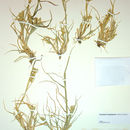Physical Description
provided by USDA PLANTS text
Annuals, Terrestrial, not aquatic, Stems nodes swollen or brittle, Stems geniculate, decumbent, or lax, sometimes rooting at nodes, Stems caespitose, tufted, or clustered, Stems terete, round in cross section, or polygonal, Stem internodes solid or spongy, Stems with inflorescence less than 1 m tall, Stems, culms, or scapes exceeding basal leaves, Leaves mostly cauline, Leaves conspicuously 2-ranked, distichous, Leaves sheathing at base, Leaf sheath mostly open, or loose, Leaf sheath hairy, hispid or prickly, Leaf sheath hairy at summit, throat, or collar, Leaf sheath and blade differentiated, Leaf blades linear, Leaf blades 2-10 mm wide, Leaf blades mostly flat, Leaf blades mostly glabrous, Leaf blades more or less hairy, Ligule present, Ligule a fringed, ciliate, or lobed membrane, Ligule a fringe of hairs, Inflorescence terminal, Inflorescence an open panicle, openly paniculate, branches spreading, Inflorescence a contracted panicle, narrowly paniculate, branches appressed or ascending, Inflorescence a dense slender spike-like panicle or raceme, branches contracted, Inflorescence solitary, with 1 spike, fascicle, glomerule, head, or cluster per stem or culm, Inflorescence with 2-10 branches, Flowers bisexual, Spikelets sessile or subsessile, Spikelets dorsally compressed or terete, Spikelet 3-10 mm wide, Spikelets with 1 fertile floret, Spikelets with 2 florets, Spikelets solitary at rachis nodes, Spikelets 1-4 in short bristly fascicles, Spikelets all alike and fertille, Spikelets bisexual, Spikelets disarticulating below the glumes, Spikelets falling with parts of disarticulating rachis or pedicel, Spikelets in bur-like clusters or fascicles with fused bracts, bristles or spines, Spikelet bristles fused together, Spikelets all subtended by bristles, Spikelet bristles 4-many, Spikelet bracts or bristles disarticulating with spikelet, Spikelets in dense head-like clusters, Rachilla or pedicel glabrous, Pistillate spikelet enclosed in hard bony involucre, Glumes present, empty bracts, Glumes 2 clearly present, Glumes distinctly unequal, Glumes shorter than adjacent lemma, G lumes equal to or longer than adjacent lemma, Glumes 1 nerved, Glumes 3 nerved, Glumes 4-7 nerved, Lemma similar in texture to glumes, Lemma coriaceous, firmer or thicker in texture than the glumes, Lemma 3 nerved, Lemma 5-7 nerved, Lemma glabrous, Lemma apex truncate, rounded, or obtuse, Lemma awnless, Lemma straight, Palea present, well developed, Palea membranous, hyaline, Palea about equal to lemma, Stamens 3, Styles 1, Styles 2-fid, deeply 2-branched, Stigmas 2, Fruit - caryopsis, Caryopsis ellipsoid, longitudinally grooved, hilum long-linear.
Cenchrus longispinus: Brief Summary
provided by wikipedia EN
Cenchrus longispinus is a species of grass, also known as spiny burr grass or gentle Annie. Its fruits are clumped into "burrs" with sharp, barbed spines that can penetrate the hides and mouth of grazing animals. They can also become lodged in human clothing, causing some discomfort. This activity is important for the plant's seed dispersal, as the plant is a summer annual. The species has a prostrate habit when there is no competition for light.
The species is native to North America (Canada, Mexico, and the United States). It is a noxious weed in Europe, Australia and New Zealand where it was introduced.
- license
- cc-by-sa-3.0
- copyright
- Wikipedia authors and editors

